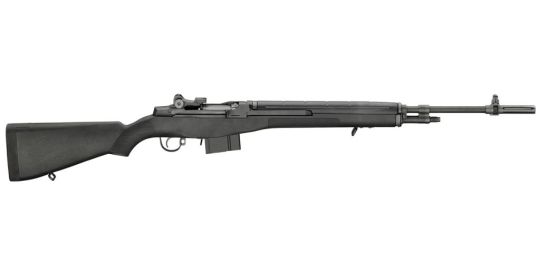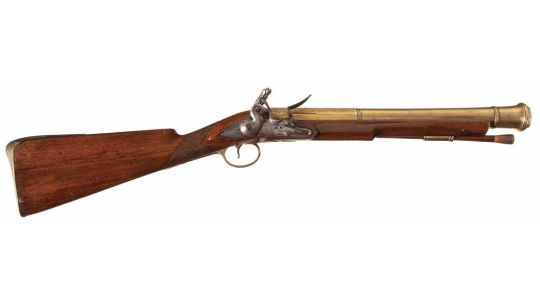#Mauser M1893
Text
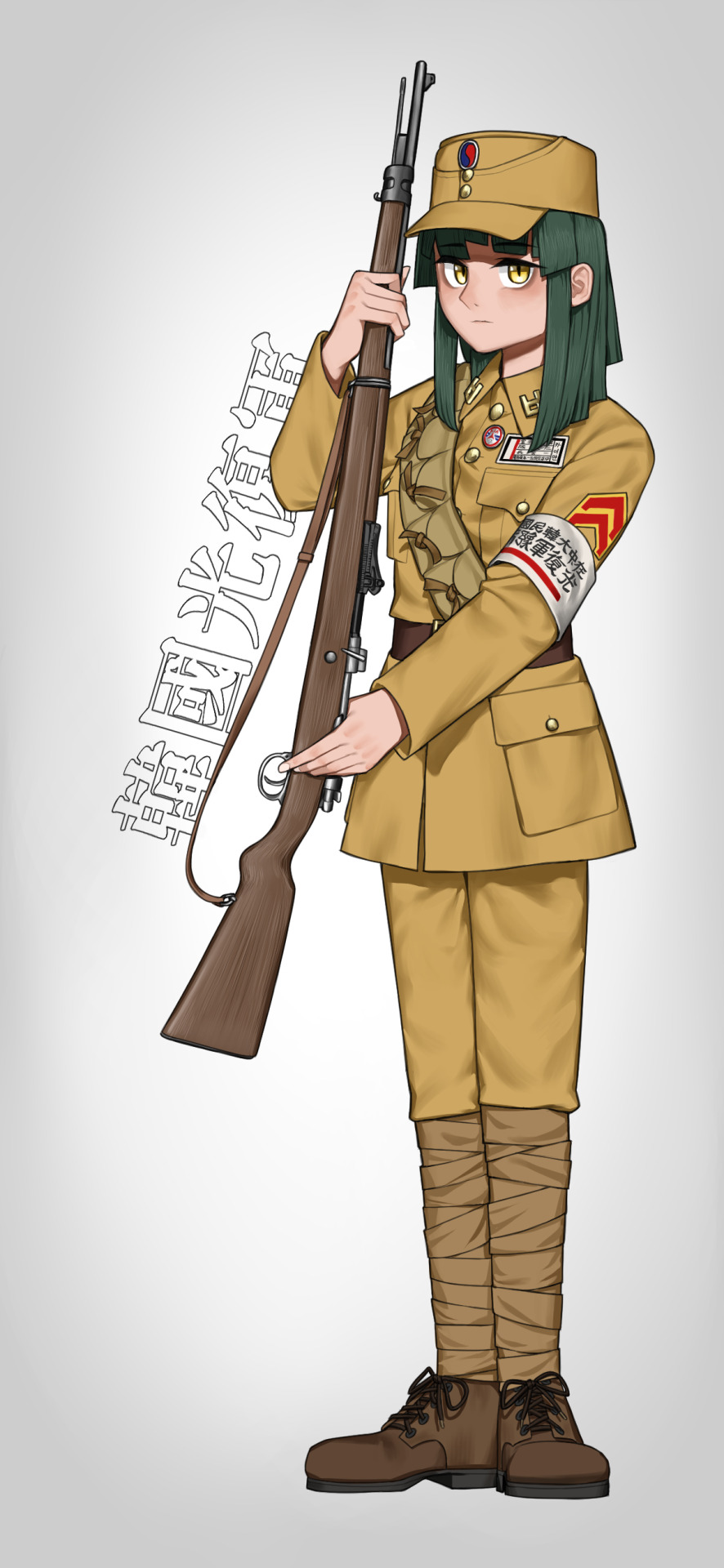
Korean Liberation Army
6 notes
·
View notes
Text
Springfield M1903
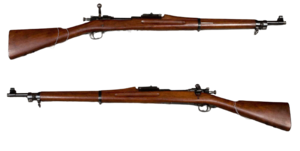
Officially designated as the United States Rifle, Caliber .30-06 model 1903, the Springfield M1903 rifle was the standard issue rifle of the United States Military through a series of wars. This included the Philippine-American war, World War One and most of World War Two. Although being replaced by the M1 Garand in 1936, it still saw use as a sniper during the later half of WW2, Korean, and Vietnam war. The M1903 is a bolt action, magazine fed (internal magazine), repeating rifle. The M1903 was the replacement for the Springfield Krag-Jorgensen rifle and other single shot rifles the US Army had at the time. This was due to the result of Spanish soldiers using the better Mauser M1893 rifle during the Spanish-American War. It also replaced the Lee M1895 and M1885 Remington Lee used by the Navy and Marine Corps. The M1903 became a famous rifle and fan favorite between firearm enthusiasts. It remains a wonderful piece of history to collect if you still get your hands on it.
4 notes
·
View notes
Text
So, who killed Olga and Fina?
As usual, when a new volume is released, Noda edits the chapters in it which often results in us getting additional info.
In this case Noda added a scene which implies how Tsurumi somehow recovered the bullet which killed his wife and child.

I’ve not the translation of the additional parts yet but, as you can see, the bullet recovered is tiny.
Now, which were the weapons being used by the people involved in the fight?
Kiro was using a machine gun.

My speculation is this one is a Maxim gun.
It works with plenty of cartridges: 7x57mm Mauser, .303 British, .30-06 Springfield, 7.92x57mm Mauser, .577/450 Martini–Henry, 7.62x54mmR.
Sofia has a rifle.
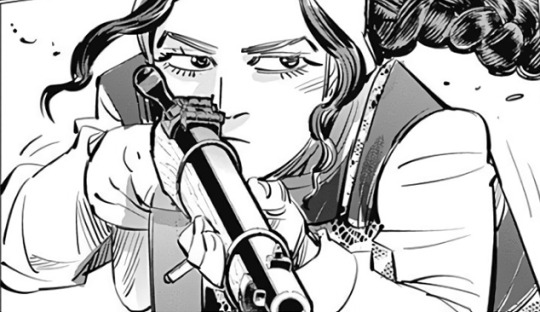
My speculation is this one is a Berdan II (M1870) rifle.
It also works with plenty of cartridges: 10.75×58 mmR; 24 gram paper-patched round nose lead bullet, 5 gram black powder; cartridge also known as .42 Berdan or 4.2 Line Berdan, 7.62×54mmR
Wilk has a gun and yes, although in the magazine version we don’t see him using it, in the volume version he does so more than once.

My speculation is this one is an early Nagant model.
It’s hard to find info on early Nagant models as web tend to cite the much more popular Nagant M1895.
The problem is the Russian emperor was murdered in 1881 and Kiro said they met Hasegawa around 10 years after, which would make the year be 1891. Sure, he’s not exactly precise so it can be we’re a little after it but in 1893 Tsurumi was back in Japan grooming Usami so at most it can be 1892, hence Nagant M1895 wouldn’t be produced yet.
So the Nagant models which existed in that time period were the Belgian M1878 and M1878-86 in 9.4mm, the Norwegian M1883 in 7.5mm, the Swedish M1887 in 7.5mm, the Serbian M1891 in 7.5mm, the Brazilian M1893 in .44 caliber and several others.
I’ll speculate more and say that’s probably a Swedish Nagant M1887 revolver in 7.5mm because visually seems to match more to that one. It’s still hard to say as the draws don’t show it perfectly.
It’s worth to note the secret police too is apparently using the same type of gun Wilk is using.
Now... I'm not a cartridge expert but the catridges for the gun Wilk had and the rifle Sofia had are different.
The visual implies Tsurumi thinks of Wilk as he watches the bullet, not of Sofia.
So, if Tsurumi holds Wilk accountable for Fina and Olga’s death and not Sofia, who instead hold herself accountable, it means the cartridge he pulled out was the one of a gun, not of a rifle.
The only thing that can be said at this point is it’s possible it wasn’t Wilk who shoot them but the escaping Russian secret policeman. As he too had the same gun and remained out of sight he could have done so, maybe mistaking her for another partisan... although, to be honest, the problem would be Sofia would have heard the shoot.
Tsurumi might have done the same reasoning and figure that, if Sofia felt responsible it meant she didn’t hear the soldier shooting at Fina and Olga... but she hadn’t shoot them herself either as the bullet was wrong.
So he blames Wilk... because it’s psychologically better than blame himself. He caused the whole situation, he caused it with his spy work, with continuing to giving lessons to Wilk and Co once he learnt who they were, with being discovered, with not managing to persuade Fina to stay away, with giving to Kiro his Maxim gun so they could fight better.
Whoever shot Fina and Olga clearly didn’t mean to kill just a random woman and a baby, it was done in the heat of the battle as they were exchanged for enemies.
Tsurumi deep down knows that Fina and Olga died DUE TO HIM and it doesn’t really matter who fired the bullet, HE was the reason due to which it was fired. It’s just the pain it’s probably too big and he can’t cope.
Well, for a loving father it should be a terrible agony to lose his own child... and if he feels he is the cause of his own loss it should feel even worse.
Anyway, we’ll see if more info will come up, be them from Noda, from translators or from cartridges experts!
#Golden Kamuy#Tsurumi Tokushirou#Wilk#Sofia#Kiroranke#Hasegawa Olga#Hasegawa Fina#Golden Kamuy Pondering
26 notes
·
View notes
Photo
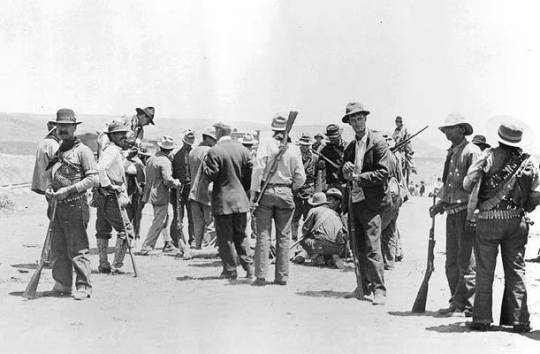
American volunteers that supported the rebellion against Diaz in Baja California, 1911. Many were armed with the outdated US Springfield breechloaders against Mexican regulars armed with M1893 Mausers.
58 notes
·
View notes
Video
youtube
M1916 Spanish Mauser .308
This is a video of my M1916 Spanish Mauser that I purchased many years back. It has been rechambered in .308. Here is some info on the gun.
The M1916 rifle was introduced in 1916. It was a shortened version of the M1893 rifle with a straight stock chambered in 7×57mm Mauser which was a common round in use by the Spanish military. Many were also converted into FR7 rifles at the end of the 1950s by re-barreling them to accept the 7.62×51mm CETME and 7.62×51mm NATO rounds for military training and Guardia Civil use.
1 note
·
View note
Text
Period weapons from an 1890 Egypt campaign
These are period- and setting-appropriate weapons I created for the 5e campaign I’m running set in 1890 British-occupied Egypt. Included are firearms commonly available at the time in the area, as well as some unconventional non-firearm weapons inspired by the unofficial Steampunk Adventurers extension by Tribality Publishing. There are also some rebalanced swords for the setting.
This post contains 14 firearms, 8 other new weapons, 4 setting-rebalanced swords, custom rules and weapon properties, and brief background information for each. The names are also linked to video clips of the weapons in action. This is a pretty long post, so the main content can be found under the cut.
I also run these items together with my custom fumble table system, which is only really noteworthy because one of the guns has an extended critical fail range, and the potential to jam is part of how guns are balanced.
Note: My campaign (and thus this post) uses the Egyptian pound (£) in place of gold, and piastres in place of copper. They use a 1:1 conversion rate and are therefore interchangeable.
Gun-specific rules
Firearm weapon properties:
Bolt-action: Fire once per turn.
Repeating action: Whether lever-action or revolving, you can use a bonus action to shoot again with disadvantage after making an attack with the weapon.
(X) triggers: This weapon has (X) barrels, each with its own trigger; they can be pulled separately or together. Triggers pulled together all use the same attack roll.
Spread: Attacks with this weapon can hit targets (enemy and allied) adjacent to the main target for ¼ of the weapon’s damage on a failed DC 10 Dex save.
Reload (X): After firing (X) shots, you must reload using an action before firing again. Both hands are required to reload a weapon. Unless otherwise specified, a reload action completely refills the weapon.
Quick load: You can reload this weapon using a bonus action.
Bayonet: This weapon can mount a bayonet. See “Bayonet” in melee section. Total weapon weight with a bayonet attached = gun weight + blade weight.
Ammunition
Calibers: Each weapon in this list denotes its caliber. How ammunition calibers are handled is up to the DM. You can enforce individual calibers, break it up by weapon type (rifle cartridge, pistol cartridge, shotgun shells/slugs, ball and powder), or just have generic all-purpose ammo.
Ammo types:
Cartridges – Most conventional guns use these. Consists of a brass casing full of gunpowder with a round/projectile of some nature on the end (bullet, slug, buckshot).
£10 for 40 rounds. DM can consider increasing the price for larger, higher-powered shots like those for the Martini-Henry and elephant gun.
Ball and powder – The technology of yesteryear, consists of a spherical lead ball and loose powder that you have to pour into the gun with each round.
£5 for 40 balls and enough powder for each.
Special ammunition:
Lightning rounds – Ammunition with an iron core magically charged with electricity. Deals extra +2 piercing damage and extra 1d4 lightning damage. Looks badass when fired from a shotgun.
£10 for 10 rounds.
Silver rounds – Has the Silvered property. Good for killing demons.
£100 for 10 rounds. (This price is from the official rules)
Conventional firearms
2-handed weapons
British service rifle: Martini-Henry lever-action rifle
(American production available in Ottoman circulation)
Price: £150
Weight: 8 lbs
Ammunition: British .577/450
Damage: 2d12 piercing
Range: 110/1100
Properties: Ammunition, Reload (1), Quick load, Two-handed, Bayonet
This lever-action rifle entered service in the British army in 1871 as the replacement for a stopgap breech-loading conversion of the 1853 Enfield musket. While it can only load a single round at a time, its breech-loading falling block mechanism was designed to enable rapid reloading of its large, easy-to-handle cartridge, allowing a trained soldier to sustain a high rate of fire over time. The weapon proved itself in the 1879 Anglo-Zulu War, when a garrison of 150 British soldiers famously defended a mission against a two-day assault of 3,000-4,000 Zulu warriors in the Battle of Rorke’s Drift. Ottoman outlaw and folk hero Hekimoğlu İbrahim was also renown for his use of the rifle in his gang’s Robin Hood-style raids against those who abused their wealth and power over the poor.
Ottoman service rifle: Mauser M1887 (Mauser Mod.71/84) bolt-action rifle
Price: £115
Weight: 10 lbs
Ammunition: 9.5 x 60R
Damage: 2d10 piercing
Range: 90/900
Properties: Ammunition, Bolt action, Reload (8), Two-handed, Bayonet
The Mauser Model 1871 and later Mod.71/84 bolt-action rifle was the first rifle produced by the Mauser brothers, and became a well-known weapon in its day with operators and export customers across the globe from Serbia and Russia to Korea and Ecuador, as well as being the standard service rifle of the new German Empire. The M1887 “Turkish Mauser” is a special Ottoman version which featured Arabic-language lettering and numerals as well as additional quality-of-life features like a second locking lug and side-mounted cleaning rod. The Ottoman variant also used a small, high-velocity round that is commonly considered the peak of black powder cartridge design; unfortunately, at the time of its introduction, the world was already transitioning to smokeless powder, and the Ottomans would soon replace their stock of M1887s with a variant of the more modern M1893 “Spanish Mauser” after witnessing its devastating effectiveness against the U.S. Army in Cuba.
Winchester 1866 lever-action rifle (Ottoman service weapon, retired)
Price: £110
Weight: 8 lbs
Ammunition: .44 Henry
Damage: 2d6+1d2 piercing
Range: 70/700
Properties: Ammunition, Repeating, Reload (17), Two-handed, Special*
*Due to this weapon’s large magazine which can only load bullets one by one, a single reload action will load half (8) of the maximum. A full-round action can be spent to load all 17.
The 1866 “Yellow Boy” was Winchester Repeating Arms' debut rifle, a significant improvement over the Henry Rifle before it and the first in what would become a long line of weapons featuring the now-iconic repeating lever action to bear the brand that was about to become a household name. Between the simple weapon sights and relatively small .44 Henry rimfire cartridge, the Winchester Rifle wasn’t especially powerful at long range, but it did have a new, much more reliable loading system for an impressive 17-round tube magazine that gave a single man the firepower of ten armed with just about anything else anywhere inside 200 meters. The Ottoman Empire adopted this weapon within a few years of its introduction, and with its high capacity and rapid rate of fire, the Winchester Rifle’s efficiency over its contemporaries spoke for itself in the 1877 Russo-Turkish War, in which the Ottomans inflicted several times greater casualties than they received.
Winchester 1873 lever-action rifle
Price: £125
Weight: 9 lbs
Ammunition: .44-40 Winchester
Damage: 2d8 piercing
Range: 85/850
Properties: Ammunition, Repeating, Reload (15), Two-handed, Special*
*Due to this weapon’s large magazine which can only load bullets one by one, a single reload action will load half (7) of the maximum. A full-round action can be spent to load all 15.
The Winchester 1873 lever-action was one of the most popular weapons of its day, marketed in America as “The gun that won the West”. Its .44-40 cartridge was Winchester’s first centerfire cartridge, which boosted accuracy and range significantly over the rimfire round used by the Model 1866 without increasing size or weight. The relatively small caliber again allowed for an impressive 15 rounds to be loaded in its tube magazine, and steel construction improved durability over the otherwise identical brass receiver of the 1866. Although variants were made targeted towards military customers, this weapon was vastly more successful worldwide in the civilian market, especially thanks to the plethora of customization options Winchester offered in its catalogue.
Winchester 1886 lever-action rifle
Price: £145
Weight: 9 lbs
Ammunition: .45-90 Sharps
Damage: 2d10 piercing
Range: 100/900
Properties: Ammunition, Repeating, Reload (9), Two-handed
With an entirely new interior mechanism designed by the prolific John Browning, the Winchester 1886 was practically state-of-the-art at its introduction. Capable of not only firing the most prominent and powerful American military-grade rifle cartridges of the era — a goal that long eluded Winchester’s older designs — the rifle was also able to easily transition into the high-powered smokeless powder era mechanically unmodified, with only the addition of a stronger nickel-steel barrel. Although ammunition capacity was decreased versus earlier models due to the larger caliber, the 1886 enjoyed significantly higher range and stopping power, comfortably filling the market gap for a high-powered rifle left by the recent discontinuation of the respected but aged Sharps rifle.
Generic militia bolt-action rifle (fictional)
Price: £30
Weight: 8 lbs
Ammunition: 11mm rounds, bolt action
Damage: 2d4 piercing
Range: 80/800
Properties: Ammunition, Bolt action, Reload (5), Two-handed, Bayonet
Generic cheap weapon for use by low-level NPCs. I like to give militiamen-type NPCs using this weapon a “bayonet charge” ability that lets them shoot, run forwards, and stab with their bayonet all in one turn, both for flavor in interesting battle scenes as well as for the sake of granting a small buff to an otherwise deliberately mediocre rifle.
Double-barrel shotgun
Price: £150
Weight: 7 lbs
Ammunition: 12g buckshot
Damage: 2d8 per barrel
Range: 30/90
Properties: Ammunition, 2 triggers, Reload (2), Quick load, Spread, Two-handed
Simple, iconic. The specific manufacturer is less important than its mechanical simplicity and raw stopping power.
Sawn-off double-barrel shotgun
Price: £150
Weight: 5 lbs
Ammunition: 12g buckshot
Damage: 2d8 piercing per barrel within 15 ft, 2d6 between 15-45 feet
Range: 15/45
Properties: Ammunition, Light, 2 triggers, Reload (2), Quick load, Spread*, Special**
*Spread Dex saves roll with disadvantage
**This weapon does not normally roll with disadvantage when attacking adjacent targets. Characters that already don’t roll adjacent firearm attacks with disadvantage instead roll with advantage.
Shortened for weight, what this weapon lacks in range it makes up for in ease of use. Indeed, a sawn-off double-barrel is virtually impossible to miss with up close, and is also significantly easier to conceal.
Elephant gun
Price: £300
Weight: 12 lbs
Ammunition: Elephant slug
Damage: 3d8 per barrel
Range: 80/400
Properties: Ammunition, Heavy, 2 triggers*, Reload (2), Special**
*If both triggers are pulled, make a DC10 strength saving throw to avoid falling prone.
**This gun always rolls with disadvantage when shooting an adjacent target, regardless of user size or abilities. It can, however, also be used as a club with club stats if needed.
Before the advent of high-power smokeless cartridges, the European solution to defeating big game in the African wild was simply to bring a bigger gun. Heavy, unwieldy, inefficient, and short-ranged, the massive smoothbore slugs fired by these so-called “elephant guns” still had unparalleled stopping power compared to its contemporaries.
1-handed weapons
British service pistol: Webley Mk.1 Revolver
Price: £140
Weight: 3 lbs
Ammunition: .455
Damage: 2d6 piercing
Range: 45/120
Properties: Ammunition, Light, Repeating, Reload (6)
The Webley was one of the first replacements for the unsatisfactory Enfield Revolver in Commonwealth service. Firing a heavy .445 cartridge, the Webley made up for its fairly unimpressive muzzle velocity with raw power. With better construction and more reliable design over the Enfield, it wasn’t uncommon for officers to already privately own some version of the Webley by the time it was adopted in the British military, with whom it was well-received and ultimately kept in service for the better half of the 20th century.
Enfield Mk II Revolver (British service weapon, retired)
Price: £100
Weight: 3 lbs
Ammunition: .476 Revolver Mk II
Damage: 2d6 piercing
Range: 40/100
Properties: Ammunition, Light, Repeating, Reload (6), critical fail on 1 or 2
Although the Enfield fires a powerful round and was initially well-received as a significant technological upgrade over its predecessor, it was still difficult to load and, worse, soon showed signs of rapid wear and tear as hinges and actions became noticeably loose after only a couple years in active service. This frequently resulted in mechanical problems and worsened accuracy, even when properly maintained, and quickly drove Commonwealth operators to search for a replacement as officers privately purchased their own alternatives.
Ottoman service pistol: Smith & Wesson Model 3
Price: £150
Weight: 3 lbs
Ammunition: .44 Russian
Damage: 2d6 piercing
Range: 50/150
Properties: Ammunition, Light, Repeating, Reload (6), +1 to attack rolls
The popular export version of the S&W Model 3 fired the innovative .44 Russian cartridge, progenitor to the legendary .44 Magnum and renowned in its day for its high muzzle velocity and record-setting accuracy. The Model 3 and .44 Russian saw widespread use at home and around the world in both civilian and military service, commonly found at the side of outlaws, police, and officers alike. Proliferation of unlicensed foreign-made copies of both gun and cartridge was so large that Smith & Wesson actually almost went bankrupt over one of its most popular products.
Colt 1851 Navy Revolver (Ottoman service weapon, retired)
Price: £75
Weight: 3 lbs
Ammunition: .36 Navy lead balls with cotton/grease and powder
Damage: 2d6 piercing
Range: 35/95
Properties: Ammunition, Light, Repeating, Reload (6)* — Cannot reload in combat (4 minutes outside combat)
A classic Old West revolver favored by the legendary law enforcer “Wild Bill” Hickok, the 1851 Navy Revolver still managed to find its way into Ottoman service in the Russo-Turkish War of the late 1870s despite its marked obsolescence versus the S&W Model 3 used by the Russians — indeed, the Colt Navy soon saw itself replaced in Ottoman hands by the very same Model 3 firing .44 Russian cartridges. Using the ball and cap ammunition of yesteryear, this weapon requires the user to carry separate pouches for lead balls, cotton patches or grease, percussion caps, and a tube of black powder to load — a rather arduous and infeasible process in the heat of battle.
Ottoman knife-gun (firearm, simple melee)
Price: £100
Weight: 3 lbs
Ammunition: 11mm
Damage: 2d6 piercing (ranged), 1d4 piercing (melee)
Range: 30/90
Properties: Ammunition, Light, Loading
Handsomely engraved on every surface and sheathed rather than holstered, this ornate weapon fuses a single-shot pistol together with a dagger extending from underneath the barrel. Arguably more beautiful than it is functional, but as far as conversation pieces go, it’s still pretty deadly.
Conventional blades
Bayonet (martial melee)
May be affixed or removed from a compatible rifle as a bonus action. Characters proficient with both bayonets and rifles wielding a bayonet-equipped rifle get +1 AC against melee weapon attacks while in single combat (i.e., fighting 1v1 against another creature attacking them with a sword or other such weapon).
Price: £9
Weight: 2 lbs
Unattached:
Damage: 1d4 piercing
Properties: Light, Finesse
Attached:
Damage: 1d6 piercing or bludgeoning
Properties: Two-handed
A knife- or short sword-sized blade of nearly universal issue in contemporary militaries, the bayonet gives the frontline soldier both a survival tool as well as a deadly melee-range weapon that effectively transforms a regular rifle into a two-handed spear with which they are trained to use both offensively and as a defensive parrying tool.
There’s no explicit rules disadvantage to just keeping the bayonet on the rifle all the time, although it may be dangerous or awkward during acrobatics/athletics checks or similar, and NPCs may be wary of somebody walking around wielding a bayonet out of combat.
Khopesh (martial melee)
Price: Generally unavailable from vendors
Weight: 4 lbs
Damage: 1d4 slashing or bludgeoning
Properties: Light, Special*
*The Khopesh has advantage in disarming attacks due to its hooked tip.
The khopesh sickle-sword was more or less the only sword type commonly used in ancient Egypt. The blade featured a unique hook shape derived from the battleaxe, bladed on one side and blunt on the other. This made it ideal for disarming opponents and defeating the light shields of its day, but also increased inertia and made it harder to make rapid consecutive attacks. A standard infantry weapon in the ancient Egyptian army, the khopesh was also a symbol of power, often wielded by the pharaohs themselves — although the design didn’t outlive the Iron Age and modern steel productions are rare, an entrepreneuring “archaeologist” may just find a magically enhanced specimen used by some great figure in millennia past, if they look in the right places...
Sabre (martial melee)
Price: £35
Weight: 3 lbs
Damage: 1d8 slashing or piercing
Properties: Finesse, Light
This lightweight cavalry sword is common among British officers and sailors. The sabre is a marriage of the Turkish kilij scimitar with the European style of backsword, an evolution that began with the adoption of the kilij by Hungarian cavalry in the 15th century. Unlike both of its progenitors, however, the lightly-curved British Pattern 1890 sabre features both a bladed cutting edge and sharpened tip, allowing for both slashing and stabbing attacks — the best of both worlds in each side of a highly contentious debate among cavalry sword users at the time.
Scimitar (martial melee)
Price: £10 (only change from official rules)
Weight: 3 lbs
Damage: 1d6 slashing
Properties: Finesse, Light
The iconic scimitar has a thousand-year history in the region, dating back as early as the 9th century. Although traditionally a cavalry sword, it’s as ubiquitous as it is varied, found commonly throughout the Ottoman Empire among civilians and militias both on foot and horseback alike, even as the national military transitioned to the European sabre — a blade itself derived from the Ottoman kilij scimitar.
Shortsword (martial melee)
Basically the same as in the official rules but it costs £25. All I really did with the scimitar and shortsword was flip the prices for the setting due to regional availability, since weapons in D&D aren’t solely priced just by their stats.
Special weapons
Bola (martial ranged)
A set of weights attached to interconnected lines, thrown to tie up a target’s legs. If a large or smaller target is hit, it falls prone and makes a contested Dex check against the thrower. If it fails the check, it is restrained. It or an adjacent ally can make a DC10 strength check to free the restrained target, or an AC10 attack with a bladed weapon or tool. Bola is destroyed if escaped from.
Price: £1
Weight: 2 lbs
Damage: 1d4 bludgeoning
Range: 10/20
Properties: Thrown
Boomerang (martial ranged)
This thrown weapon returns to the user on attack rolls other than a 1.
Price: £1
Weight: 1 lb
Damage: 1d4 bludgeoning
Range: 100/300
Properties: Thrown, Are you sure you know how to use this?
Brass knuckles (simple melee)
Gives bonus +1 damage and critical range to unarmed strike.
£10, 1 lb
Cane (simple melee)
How dapper.
Price: £10
Weight: 1 lb
Damage: 1d4 bludgeoning
Properties: Light
Cane pistol (firearm)
A small pistol concealed in an ornate walking cane that looks like an ordinary cane when inspected. A DC 15 Investigation check reveals the hidden weapon. Attacking with the cane itself uses cane stats.
Price: £200
Weight: 4 lbs
Ammunition: .22
Damage: 2d4 piercing
Range: 15/45
Properties: Ammunition, Light, Reload (1), Quick load
Cane sword (martial melee)
A shortsword concealed in a walking cane that looks like an ordinary cane when inspected. A DC 15 Investigation check reveals the hidden weapon. Attacking with the cane itself uses cane stats.
Price: £50
Weight: 3 lbs
Damage: 1d6 piercing
Properties: Light, Finesse
Whip (martial melee)
If hit, target and attacker make a contested Dex check; target is knocked prone if it loses.
Price: £5
Weight: 2 lbs
Damage: 1d4 slashing
Properties: Light
2 notes
·
View notes
Photo

Infantrymen of the Mexican federal army, 1911 in Baja California. They are wearing a the traditional bleached linen uniforms and kepis that had been introduced since the late 1870s. They are all armed with the Mexican versions of the M1893 Mauser.
8 notes
·
View notes
Photo

Mexican federal forces c. 1914. All are wearing bleached linen uniforms and the newly introduced British style peaked caps that had replaced the older French-pattern kepi. All of the men are armed with the Mexican variant of the M1893 Spanish Mauser or other closely related Mauser types.
1 note
·
View note






